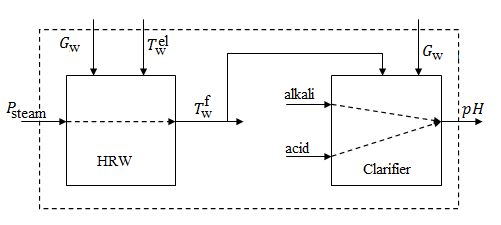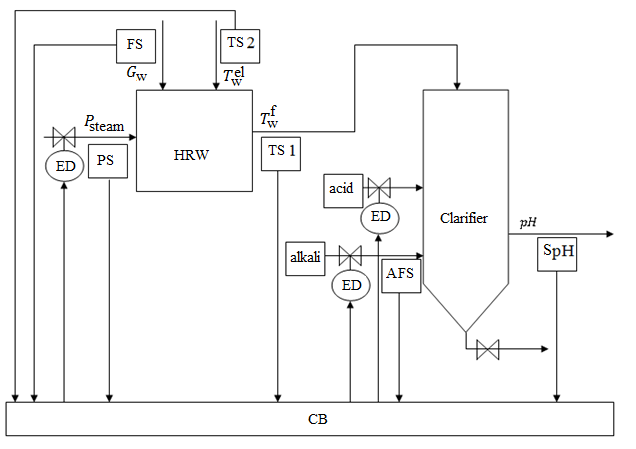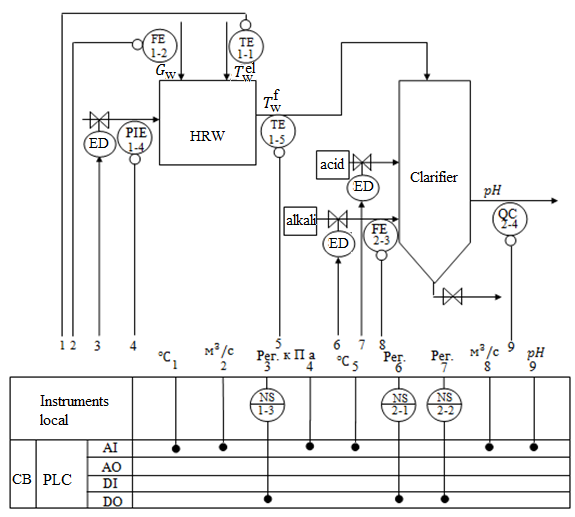Abstract
Content
- Introduction
- 1 Relevance
- 2 Analysis of the automation object
- 21 Technology object diagram
- 22 Principle of operation of the system
- 3 Designing of automatic control system
- 31 The rationale for the direction
- 32 Functional diagram of the control system
- 4 The purpose and objectives of the study
- Conclusions
- Source List
Introduction
Chemical water treatment is a common object, automation which can significantly improve the efficiency and convenience of the staff. At the same time, in terms of automation, chemical water treatment (hereinafter HVO) has specific features that affect the efficiency of automation equipment, common in the energy sector.
Thus, the quality of water treatment on the thermal power plant is closely related to reliability and economy of operation of modern high-boiler and turbine equipment with the safety of nuclear power plants.
1 Relevance
The technological process of chemical treatment of water substantially is crucial for efficient operation of the main equipment combined heat and power (CHP) and heating systems, which, in particular, shows the high social importance of this process. The quality of the chemical water treatment is one of the most important factors that directly shape the basic characteristics of electricity and heat supply systems of the population and industrial enterprises [1].
heating network feeding equipment is very cumbersome, spread out over a large area of chemical plant and partly outside it, making it difficult to organize effective management of the process manually.
This work is relevant, since the chemical water treatment is widely used in practice, with regard to the energy industry, not only in TPP, but also in NPP, of course, equipped with the appropriate automation. Some TPP such automatic control system (ACS) is not available, although the process of chemical treatment is carried out, provides products, but is controlled manually by operators. Therefore, it became necessary to design and put into operation the ATS chemical treatment of water [2, 3].
2 Analysis of the automation object
21 Technology object diagram
chemical water treatment system consists of several interconnected processes. The first process is the heated feedwater. At this stage, the initial water is heated with steam from the collector's own needs TPP by the preheater the raw water (PSV) to a temperature of 30 ± 10 °C. Feed water enters the steam heater, and fed with steam. At the outlet of water steam heater obtain a predetermined temperature which enters the clarifier, where the water treatment step occurs [4, 5].
Based on the above given two control loops can be identified ACS:
- stabilization circuit feedwater temperature in the heat exchanger;
- stabilization pH‑parameter in an illumination tank
The relationship between the input and output parameters is shown in Figure 1.

Figure 1 – The relationship between the input and output parameters
22 Principle of operation of the system
Currently, maintaining the pH‑parameter is carried out as follows. The first circuit, namely, pH‑stabilizing illumination parameter tank is essential. Water clarification consists of two processes: liming and coagulation. The aim of the process of coagulation combined with liming is to get on the water outlet with preset levels of quality, the value of which corresponds to the required pH. Parameter pH should be maintained within the range 10,1–10,2. The temperature of hot water will be a disturbance to the process. Control ratio allows you to control, monitor, and change the level of pH. Initially, the clarifier water is heated to a certain temperature. The first material is fed acid consumption is determined by the experimental method, ranging from 0,25–0,75 mEq/L [9].
3 Designing of automatic control system
31 The rationale for the direction
To achieve this goal it is necessary to design the automation system, which will receive all the necessary information about the system parameters that characterize and influence on her work.
The main objective of ACS – increase productivity by changing the water level in the intermediate tank. Secondary objectives are – heating water to a predetermined temperature value and maintaining the value of pH‑parameter with unstable water consumption.
Measurement of the current temperature value is made by means of temperature sensors, the value pH‑parameter – using a pHACSmeter, flow rate – using a flow meter. Data processing and delivery control signals for the valves to be produced by a programmable logic controller (PLC).
Thus, the above scheme allows to develop automation processes chemical treatment of water, shown in Figure 2.

Figure 2 – Automatic control of chemical treatment of water
ED – electric drive, FS – flow sensor, TS1 – initial water temperature sensor, TS2 – water temperature sensor end, PS – steam pressure sensor, AFS – alkali flow sensor, SpH – pH‑parameter sensor, HRW – raw water heater, CB – control block.
32 Functional diagram of the control system

Figure 3 – Functional diagram of the automatic process control chemical treatment of water
Principle of operation.
ACS heat exchange. Water is fed into heating steam, water flow sensor (1–2) controls the amount of water. Temperature sensor (1–1) measures the temperature of the source water, then fed pairs (1–3) and is regulated by a pressure sensor (1–4). temperature sensor at the outlet of heating steam (1–5) measures the temperature of the heated water.
ACS stabilize the pH‑parameter in the lighting tank. After clarification served acid (2–2) alkali and then fed (2–1), the consumption of alkali sensor adjusts (2–3). At the outlet of the clarifier stands measuring the concentration sensor in the water content of pH (2–4).
4 The purpose and objectives of the study
The purpose – improving the efficiency of thermal power plant chemical water purification process through the development of the automatic control system, which will improve the quality of treatment, extend the life of thermal power plant equipment and improve the reliability of TPP members.
To achieve this goal it is necessary to solve the following tasks:
- To carry out selection of items ACS.
- Develop a functional block diagram of ACS.
- The mathematical model of the chemical treatment of water.
- Using a mathematical model to perform a theoretical synthesis of the desired control algorithms.
- To assess the effectiveness of the proposed control algorithms by mathematical modeling.
Conclusions
In the course of the work it was designed by the chemical process ACS TPS water purification. ACS effectively solves its tasks, due to what is achieved by the system set for the purpose – maintenance on predetermined level of water temperature, pH-parameter and water consumption.
Inspect existing systems of automatic control of chemical water treatment. Analysis of the chemical treatment system of large TPP showed that the developed system is more efficient and cheaper to build, than the use of ready‑made options from leading companies.
water heating circuit structure and regulation of pH‑parameter have been developed. The mathematical model of the control object and the whole ACS. system modeling performed in the package Matlab and Simulink software.
The scheme of automatic control of water treatment chemical, based on which the hardware were chosen formulated to implement the control and management functions. The functional chemical treatment of water management scheme.
In writing this essay master's work is not yet complete. Final completion: June 2017. The full text of work and materials on the topic can be obtained from the author or his manager after that date.
Source List
- Лукас В. А. Теория управления техническими системами. Учебный курс для вузов. Екатеринбург: Издательство УГГГА, 2002. – 675 с.
- Дорф Р., Бишоп Р. Современные системы управления. – М.: Лаборатория Базовых знаний. – 2002 – 832 с.
- Федюн Р В., Попов В. А., Найденова Т. В. Принципы построения динамической модели процесса биохимической водоочистки. Наукові праці ДонНТУ. Серія: Обчислювальна техніка та автоматизація. Випуск 20 (158). – Донецк, ДВНЗ
ДонНТУ
, 2010. – с. 30–37. - Федюн Р. В., Найдьонова Т. В., Юрченко Р. В. Математична модель технологічного процесу біохімічного водоочищення. Наукові праці Донецького національного технічного університету. Серія: Обчислювальна техніка та автоматизація. Випуск – 22 (200) – Донецьк, ДонНТУ, 2012. – с. 48–55.
- Федюн Р. В., Попов В. О., Бунєєв В. О. Автоматичне управління гідравлічними параметрами системи водопостачання. Наукові праці ДонНТУ. Серія: Обчислювальна техніка та автоматизація, Випуск 14 (129). – Донецк, ДонНТУ, 2008. – с. 54–63.
- Плановский А. Н., Рамм В. М., Каган С. З. Процессы и аппараты химической технологии – 2 издание, дополн. – М.: Госхимиздат, 1962. – 846 с.
- Рыбалев А. Н. Автоматическое управление энергетическими установками А. Д. Качан. – Благовещенск, 2007 – 94 с.
- Иванова Г. В. Автоматизация технологических процессов основных химических производств: Методическое пособие/СПбГТИ(ТУ). – СПб., 2003 – 140 с.
- Федюн Р. В., Попов В. О., Бунєєв В. О. Автоматичне управління гідравлічними параметрами системи водопостачання. Наукові праці ДонНТУ. Серія: Обчислювальна техніка та автоматизація, Випуск 14 (129). – Донецк, ДонНТУ, 2008. – с. 54–63.
- Ефимов В. Т., Молчанов В. И., Ефимов А. В. Методы расчетов в автоматизации химико–технологических и теплоэнергетических процессов: Учебное пособие. Харьков, 1998.
